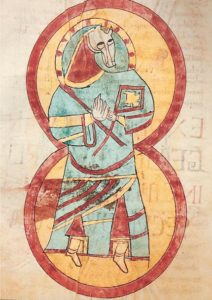Images and words in exile : Avignon and Italy in the first half of the 14th century (1310-1352)
Images and words in exile : Avignon and Italy in the first half of the 14th century (1310-1352)
At the start of the fourteenth century, far-reaching political events rapidly changed the set-up of the Mediterranean basin and together distorted the ‘Ordo universalis’ through which the material and symbolic space of ‘Christianitas’ had, for centuries, been understood.
While the ‘topos’ of the Avignon papacy, or \ »Babylonian Captivity\ », progressively took hold and Rome was increasingly portrayed as the new abandoned Jerusalem, the court of Avignon offered the opportunity for a political, cultural and artistic experimentation. The increasing use of the political tool of banishment, the proliferation of accusations of heresy, the bitterly contested ‘quaestio de paupertate’ and, from a mystic-theological perspective, the ‘quaestio de visione beatifica’, are ones of the ways in which the new Christianity attempted, on different scales, to redefine its identity though exclusion practices.
On a different level, self-exclusion, pursued or accepted, is a rediscovered path for self-affirmation. We need only think about, to give two examples, the new forms of eremitism and Dante’s ‘Commedia’, according to some the first modern work of the ‘Exilliteratur’ for the role accorded to the state of exile in constructing the figure of its author.
Exile, a mental image that has always been linked to the period of Avignon papacy, is the lens through which this interdisciplinary Conference aims to interpret the first half of the 14th century, from Henry VII’s imperial expedition which came to an unexpected end with his death at the gate of Siena, the moment when the irreversible nature of the Papal Curia’s transfer to France (1309-1313) became clear, up until the end of the papacy of Clement VI (1352).

Avignon BM 71, f. 3v. St Matthieu écrivant. XVe s. © IRHT/CNRS/BM Avignon
Firenze & Avignon, 7–11 April 2011
Program
Thursday 7 April, Firenze, KHI (Palazzo Grifoni)
9.00 am-9.15 am
Gerhard Wolf Opening Remarks
Session 1 Exclusion from the Civitas
9.15 am-2.00 pm
Chair: Jean-Claude Maire Vigueur (Roma)
Fabrizio Ricciardelli (Villa Le Balze) Le modalità dell‟azione politica a Firenze in età comunale
Matteo Ferrari (Pisa) Tradizione figurativa del bando politico tra Lombardia e Toscana
Gaetano Curzi (Chieti) La “condanna” dei Templari. Tracce materiali e memoria negata tra Francia e Italia
11.30 am, Coffee break
Irene Bueno (Firenze/Leiden) Come estirpare le cattive piante. La riflessione sull‟eresia nell‟opera esegetica di Jacques Fournier
Fabio Massaccesi (Bologna) Da Avignone a Ravenna: Giovanni XXII e Aimerico di Châtelus. Immagini e politica in Santa Maria in Porto Fuori
1.15 pm, Discussion
Session 2 Self-exclusion from the Civitas
3.00 pm-8.00 am
Chair: Sofia Boesch Gajano (Roma) Antonio Montefusco (Roma) Exsul pauper. Auto-esclusione e condanna nella tradizione monastica e francescana
Stefania Paone (Cosenza) L‟immagine di Pietro del Morrone tra l‟Abruzzo, Roma e Avignone
4.30 pm, Coffee break
Marianne Besseyre (Paris) Les “Vies des Pères”, un manuscrit italien du XIVe siècle entre France et Italie
Alessandra Malquori (Firenze) L‟immagine dell‟anacoreta tra mistica e predicazione. Pittura tra Firenze e Pisa nella prima metà del Trecento
Luca Marcozzi (Roma) Retorica dell‟esilio nella poesia lirica di Petrarca
7.00 pm, Discussion
Friday 8 April, Firenze, KHI (Casa Zuccari)
Workshop Works in Progress on Exile
9.00 am-10.30 am
Moderators: Elisa Brilli and Laura Fenelli (Firenze)
Anna Fontes Baratto (Paris) Présentation d‟un projet de recherche du CERLIM sur l‟exil dans la littérature italienne médiévale
Alessandra Malquori (Firenze) Atlante dei temi figurativi della Tebaide
Visit I Firenze, Santa Croce
11.00 am-1.00 pm
Andrea De Marchi (Firenze) Un‟altra Santa Croce. Una visita selettiva e una lettura in filigrana dei primi programmi decorativi.
Saturday 9 April, Avignon, Musée du Petit Palais
10.30 am-10.50 am
Dominique Vingtain Opening Remarks
Session 3 Displaced Persons
10.50 am-3.30 pm
Chair: *to be confirmed.
Giuliano Milani (Roma) Appunti per una rilettura del bando di Dante
Dieter Blume (Jena) Francesco da Barberino. The Experience of Exile and the Allegory of Love
12.20 am, Lunch Break
Sylvain Piron (Paris) Les exils de Opicinus de Canistris
Marina Gagliano (Paris) “Hierosolymitanus exul inter et super flumina Babilonis indignans scripsi”. La polemica antiavignonese di Petrarca e il modello di Dante exul
2.50 pm, Discussion
Evening Lecture
4.30 pm
Agostino Paravicini Bagliani Avignon, une autre Rome?
Sunday 10 April, Avignon, Musée du Petit Palais
Session 4 Avignon : the Making of a Capital
9.00 am-1.30 pm
Chair: Gerhard Wolf (Firenze)
Joëlle Rollo-Koster (Kingston) Avignon‟s Capitalization and the Legitimation of Transiency
Xavier Barral-Altet (Rennes-Venezia) Afficher l‟exile à l‟extérieur du palais. L‟entrée monumentale du Palais des Papes d‟Avignon
Barbara Bombi (Canterbury) The “Avignon Captivity” as Means of Success. The Circle of the Frescobaldi
11.15 am, Coffee break
Etienne Anheim (Versailles) Simone Martini à Avignon: une histoire en négatif ?
Francesca Manzari (Roma) Le opportunità offerte dall‟esilio. Elementi multiculturali e libertà d‟innovazione nella miniatura avignonese del Trecento
1.00 pm, Discussion
Session 5 Exchanging Glances
2.30 pm-6.00 pm
Chair: Serena Romano (Lausanne)
Maria Alessandra Bilotta (Paris) Avignon comme Bologne? Remarques sur le rôle d‟Avignon dans la production des manuscrits juridiques
Claudia Bolgia (Edinburgh) Images in the City. Presence, Absence and „Exile‟ in Rome in the first half of the 14th century
4.00 pm, Coffee Break Theresa Holler (Firenze) L’Aldilà della Cappella Strozzi. I domenicani, l’esilio di Dante e il ritorno dell’Inferno
Francesco Pasquale (Venezia) Napoli traslata. Roberto d‟Angiò e la sua corte ad Avignone
5.45 pm, Discussion
Monday 11 April, Université d’Avignon (salle 2E02)
Session 6 Imagining Avignon‟s Cartography
9.00 am-1.00 pm
Chair: Michel Laclotte (Paris)
Stephan Zanke (Augsburg) Imagined spaces? John XXII, the papal Registers and European Policy (1316-1334)
Gottfried Kerscher (Trier) Hofordnung- Rangordnung-Raumordnung. Disruptive Changes in Avignon
Tina Sabater (Palma de Mallorca) Intorno all‟influenza della corte di Avignone sull‟arte. La pittura maiorchina del XIV secolo
11.15 am, Coffee break
Rosa Alcoy (Barcelona) Avignone e la Catalogna dei Bassa
Alessandro Tomei (Chieti) Opere e artisti in esilio tra Italia e Provenza (con qualche ritorno). Modelli, stili e iconografie
1.00 pm, Discussion
Visit II Avignon
3.00 pm
Marie-Claude Léonelli (Avignon) and Dominique Vingtain (Avignon) Décors peints médiévaux avignonnais, entre France et Italie
Participation in the Conference is free, contact us for information on the visits Scientific Coordination : Elisa Brilli, Laura Fenelli, Gerhard Wolf
Contacts:
Dr. Elisa Brilli: Brilli(at)khi.fi.it
Dr. Laura Fenelli: Fenelli(at)khi.fi.it
www.khi.fi.it
+ 39 0552491153
Quelle: KHI Florenz
(Source : Maria Alessandra Bilotta)
Leave a comment
PAGES ANNEXES
Auteur du blog : Jean-Luc DEUFFIC




